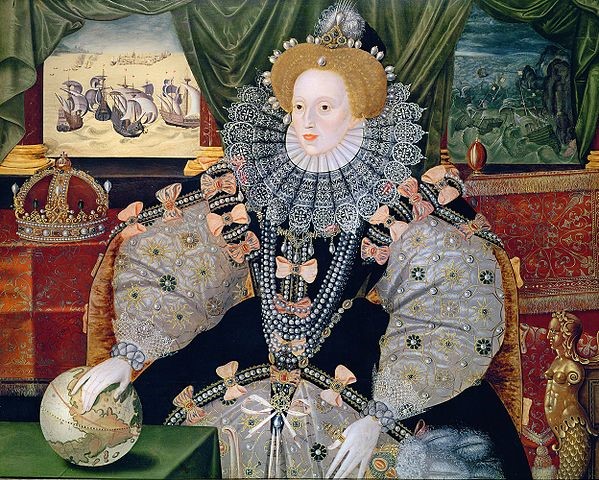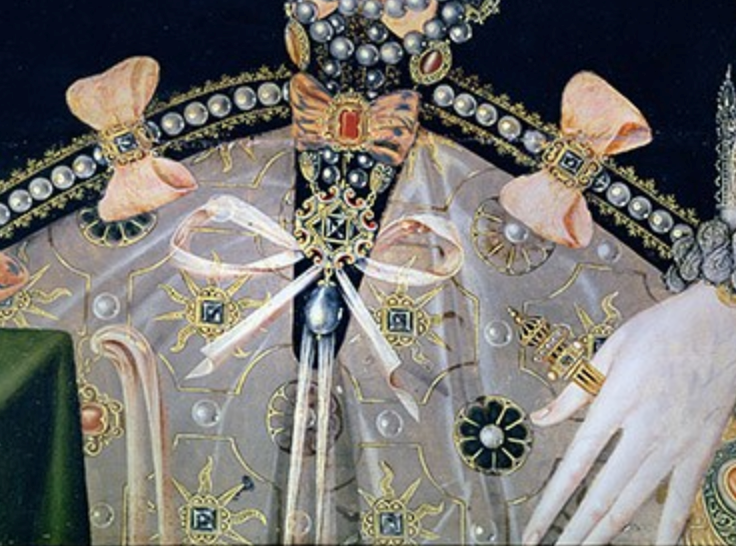Kaara Peterson: Oxford University’s “pendant pearl” portraits of Queen Elizabeth I
Oxford University’s “pendant pearl” portraits of Queen Elizabeth I
Dr. Kaara L. Peterson (Miami University of Ohio), Plumer Visiting fellow, Spring 2019
If research I conducted at Oxford this year as a Plumer Visiting Fellow from late January until early April proved highly rewarding for my own projects, an especially interesting discovery I made visiting several colleges’ art collections is also more broadly relevant to art and cultural historians studying Queen Elizabeth I. A great deal of attention has been focused by scholars of various stripes on Elizabeth’s predilection for lavish jewelry, especially the pearls particularly associated with the “virgin queen” in countless portraits—in great ropes, suspended from jewels, and as individual pearls sewn onto her clothing by the dozen. Some of these pearls were so ostentatious that they were reported to be as big as “nutmegs.” A well-documented sale to Elizabeth of the exquisite Médici family pearls, “les plus belles perles du monde,” originally given as a nuptial gift by Catherine de Médici to Mary, Queen of Scots, offers an example of a particularly treasured item of the queen’s wardrobe with a distinct provenance. Similarly, in his will, the Earl of Leicester bequeathed his queen “a rope of 600 fair white pearls.”
Probably the most famous jewelry items worn by Elizabeth in a work of art more familiar to many, however, is the large pearl that appears hanging from a pink-ribboned jewel in the “Armada” portrait (1588) by the queen’s serjeant painter George Gower at Woburn Abbey (below; other copies are in London at Greenwich and the NPG).
While this portrait of Elizabeth wearing the tear-drop shaped pearl is of great interest to early modern scholars Louis Montrose and Valerie Traub for its telling similarity to Henry VIII’s codpiece as portrayed by Holbein in a famous 16th-century work of the imposing king, Gower’s tableau depicting Elizabeth has not previously been recognized as the first in a series of artworks that can be said to document a particular style of pearl jewelry worn by the queen. Comprising an identifiable sub-group, there are at least eleven such “pendant pearl” portraits of Elizabeth. Like another group of paintings commonly labeled “sieve” portraits by art historian Roy Strong for their depictions of Elizabeth modeled after the vestal virgin Tuccia who holds a sieve in her hand, all eleven works in the “pendant pearl” group reveal the queen wearing a pendant pearl in a distinctive manner, either suspended from a jewel, sometimes with a bow, or hanging from a girdle.
Establishing that this genre of “pendant pearl” portraits existed began in earnest on site when I realized that four of these paintings were, somewhat remarkably, in Oxford University collections. The work attributed to Hilliard at Jesus College’s Hall (c. 1590), two portraits at Christ Church College’s Deanery and Hall, and the painting in Duke Humphrey’s Library in the Bodleian attributed to Sonmans (c.1670) are all at Oxford. Three of the four Oxford paintings depict a pendant pearl in the same position as the three extant versions of Elizabeth’s Armada portrait while, in its variation on a theme, one of the Christ Church works places the pendant pearl above the bow and adds a second pendant pearl hanging from Elizabeth’s bodice brooch—arguably the size of a nutmeg. This pendant pearl style is entirely uncommon in English fashion from c. 1588 onwards and is apparently unique to Elizabeth in English aristocratic portraiture, at least as established by my research to date. Oxford’s four “pendant pearl” works can thus be seen to form an important chapter in Elizabethan-era material cultural and art history.
Where might the queen have developed her taste for this characteristic pearl accessory? Once again we can look for clues in the Médici court, from whom Elizabeth seems to have borrowed her style of pearl ornamentation again and again, as the sizeable number of works in the portrait group documents. The mid-16th to early 17th-century depictions of Médici women by court artists Allori and Pulzone reveal a fashionable wealth of pearls predating the Tudor queen’s vogue. Of course, after Elizabeth’s reign ended in 1603, King James’ queen, Anne of Denmark, borrowed liberally too from her predecessor’s fashion for the new tastes of the Stuart court. It is Elizabeth, however, who is known for the remarkable pearl jewelry commemorated in the “pendant pearl” group—quite literally jewels of Oxford University’s collection.
With grateful thanks to Dr. Lorna Hutson of the CEMS; Dean Martyn Percy and Jacqueline Thalmann, Christ Church College; Susan Doran, Jitka Štollová, and Robin Darwall-Smith, Jesus College.

Portrait of Elizabeth I of England, the Armada Portrait. c.1588. Oil on panel. Wikimedia Commons, accessed 03 May 2019.

'Pendant pearl' detail from Portrait of Elizabeth I of England, the Armada Portrait.



